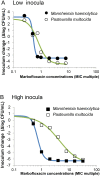Bacterial Species-Specific Activity of a Fluoroquinolone against Two Closely Related Pasteurellaceae with Similar MICs: Differential In Vitro Inoculum Effects and In Vivo Efficacies
- PMID: 26506096
- PMCID: PMC4624641
- DOI: 10.1371/journal.pone.0141441
Bacterial Species-Specific Activity of a Fluoroquinolone against Two Closely Related Pasteurellaceae with Similar MICs: Differential In Vitro Inoculum Effects and In Vivo Efficacies
Abstract
We investigated the antimicrobial activity of a fluoroquinolone against two genetically close bacterial species belonging to the Pasteurellaceae family. Time-kill experiments were used to measure the in vitro activity of marbofloxacin against two strains of Mannheimia haemolytica and Pasteurella multocida with similar MICs. We observed that marbofloxacin was equally potent against 105 CFU/mL inocula M. haemolytica and P. multocida. However, an inoculum effect was observed with P. multocida, meaning that marbofloxacin activity was decreased against a 108 CFU/mL inoculum, whereas no inoculum effect was observed with M. haemolytica. Marbofloxacin activity was also tested in a lung infection model with immunocompromised mice intratracheally infected with 109 CFU of each bacteria. At the same dose, the clinical and bacteriological outcomes were much better for mice infected with M. haemolytica than for those infected with P. multocida. Moreover, bacteriological eradication was obtained with a lower marbofloxacin dose for mice infected with M. haemolytica. Our results suggest that the differential in vivo marbofloxacin efficacy observed with the two bacterial species of similar MIC could be explained by a differential inoculum effect. Consequently, MICs determined on 105 CFU inocula were not predictive of the differences in antibiotic efficacies against high bacterial inocula of closely related bacterial strains. These results could stimulate further investigations on bacterial species-specific antibiotic doses in a clinical setting.
Conflict of interest statement
Figures



References
-
- Drusano GL, Preston SL, Fowler C, Corrado M, Weisinger B, Kahn J. Relationship between fluoroquinolone area under the curve: minimum inhibitory concentration ratio and the probability of eradication of the infecting pathogen, in patients with nosocomial pneumonia. J Infect Dis. 2004;189: 1590–1597. . - PubMed
-
- CLSI. Methods for Dilution Antimicrobial Susceptibility Tests for Bacteria That Grow Aerobically; Approved Standard-Eighth Edition. Document M7-A8. 2009;29-2(ISBN 1-56238-689-1).
Publication types
MeSH terms
Substances
LinkOut - more resources
Full Text Sources
Other Literature Sources

